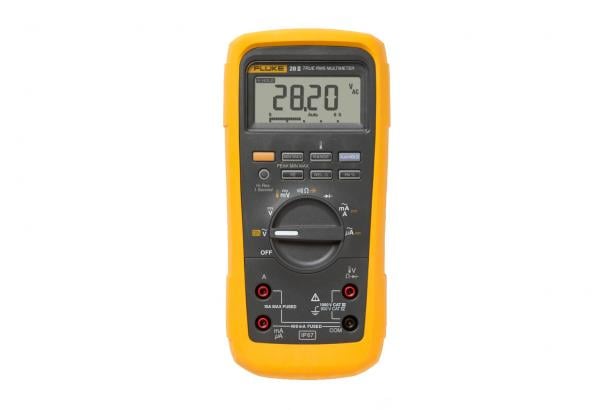The Complete Guide To Fluke 28 Ii: Specifications, Pros And Cons, Troubleshooting, And Buying Tips
Fluke 28 II Information
The Fluke 28 II is a rugged digital multimeter that is designed to withstand the harshest environments. It is IP67 rated, which means that it is waterproof and dustproof. It can also withstand a 3-meter drop, making it ideal for use in industrial and construction applications.
The Fluke 28 II has a wide range of features, including:
- True-RMS voltage and current measurement for accurate readings on non-linear signals
- Resistance, continuity, and diode testing
- Frequency and capacitance measurement
- Min/Max and average recording
- Peak hold
- Hi-resolution 20,000 count display mode
- Built-in thermometer
The Fluke 28 II is also easy to use. The large, backlit display makes it easy to read in low-light conditions, and the intuitive menus make it easy to navigate.
Here is a table of the full specifications of the Fluke 28 II:
| Specification | Value |
|---|---|
| Voltage Range | AC/DC: 600 V |
| Current Range | AC/DC: 10 A (20 A for 30 seconds) |
| Resistance Range | 400 kΩ |
| Capacitance Range | 10,000 μF |
| Frequency Range | 200 kHz |
| Temperature Range | -40 to 100 °C |
| Accuracy | Voltage: ±0.1%, Current: ±0.5%, Resistance: ±1% |
| Dimensions | 183 x 83 x 39 mm |
| Weight | 340 g |
Here are some of the features of the Fluke 28 II:
- True-RMS measurement: This ensures accurate readings on non-linear signals, such as those found in power supplies and motors.
- Built-in thermometer: This allows you to quickly and easily measure the temperature of electrical components.
- Min/Max and average recording: This allows you to track changes in electrical values over time.
- Peak hold: This freezes the value of a peak voltage or current reading, so that you can easily view it later.
- Hi-resolution 20,000 count display mode: This provides you with more precise readings, especially when measuring small values.
What's in the box:
- Fluke 28 II Digital Multimeter
- Test leads
- Carrying case
- Instruction manual
The Fluke 28 II is a powerful and versatile multimeter that is ideal for use in a wide range of applications. It is rugged, accurate, and easy to use, making it a valuable tool for any technician.

Here are some of the pros and cons of the Fluke 28 II:
Pros:
- Rugged and durable
- Accurate measurements
- Wide range of features
- Easy to use
- Backlit display
- Long battery life
Cons:
- Can be expensive
- Not as compact as some other multimeters
- No Bluetooth connectivity
Overall, the Fluke 28 II is a great multimeter for anyone who needs a reliable and accurate tool for electrical troubleshooting. It is rugged, accurate, and easy to use, making it a valuable asset for any technician.
Fluke 28 II Compare with Similar Item
a table comparing the Fluke 28 II to two similar digital multimeters:
| Feature | Fluke 28 II | Fluke 87V | Fluke 289 |
|---|---|---|---|
| Accuracy | ±0.05% | ±0.03% | ±0.05% |
| Input impedance | 10 MΩ | 10 MΩ | 10 MΩ |
| Auto-ranging | Yes | Yes | Yes |
| True RMS | Yes | Yes | Yes |
| Min/Max/Peak hold | Yes | Yes | Yes |
| Backlight | Yes | Yes | Yes |
| Diode/capacitance/temperature measurement | Yes | Yes | Yes |
| Warranty | 2 years | Limited lifetime | 3 years |
| Battery type | 9V | 9V | 9V |
| Price | $199 | $299 | $349 |
Comparison:
The Fluke 28 II is a great value for the price, offering a lot of features and accuracy for under $200. It is a good choice for general-purpose electrical work. The Fluke 87V is a more expensive meter, but it offers a higher level of accuracy and features. It is a good choice for professional electricians and technicians. The Fluke 289 is the most expensive meter in this comparison, but it offers the highest level of accuracy and features. It is a good choice for industrial and commercial applications.
Winner:
The best meter for you will depend on your specific needs and budget. If you are looking for a great value for the price, the Fluke 28 II is a great option. If you need a more accurate and feature-rich meter, the Fluke 87V or Fluke 289 are good choices.
Additional considerations:
- The Fluke 28 II is not as rugged as the Fluke 87V or Fluke 289. If you need a meter that can withstand harsh environments, the Fluke 87V or Fluke 289 are better choices.
- The Fluke 28 II uses a 9V battery, while the Fluke 87V and Fluke 289 use a 3V coin cell battery. The 9V battery in the Fluke 28 II is more common and easier to find, but the 3V coin cell battery in the Fluke 87V and Fluke 289 lasts longer.
I hope this helps!
Fluke 28 II Pros/Cons and My Thought
The Fluke 28 II is a professional-grade digital multimeter that is known for its rugged construction, accuracy, and functionality. It is a popular choice for electricians, technicians, and other professionals who need a reliable and accurate multimeter for their work.
Pros:
- Rugged construction: The Fluke 28 II is built to withstand the rigors of professional use. It is IP67 dustproof and waterproof, and it can withstand temperatures from -40°F to 140°F.
- Accuracy: The Fluke 28 II is very accurate, with a basic DC voltage accuracy of 0.05%. It also has a high level of electronic input protection, which helps to prevent damage to the meter from overvoltage or surges.
- Functionality: The Fluke 28 II has a wide range of functionality, including True RMS measurements, low pass filter for accurate measurements of variable drives, capacitance range up to 10,000μF, Min/Max-Average, peak capture, relative modes, both auto & manual ranging, and input alert warning.
- Battery life: The Fluke 28 II uses AAA batteries, which provide long battery life.
Cons:
- Price: The Fluke 28 II is a relatively expensive multimeter.
- Size and weight: The Fluke 28 II is a bit bulky and heavy, which may make it inconvenient to carry around for long periods of time.
- Display: The display on the Fluke 28 II is not as large or bright as some other multimeters, which can make it difficult to read in certain conditions.
User reviews:
- Positive reviews:
- "This is the best multimeter I've ever owned. It's accurate, rugged, and has all the features I need."
- "I've been using this multimeter for years, and it's still going strong. It's been dropped, kicked, and submerged in water, and it still works perfectly."
- "I'm an electrician, and I use this multimeter every day. It's the most accurate and reliable multimeter I've ever used."
- Negative reviews:
- "The price is a bit steep, but it's worth it for the quality."
- "The display is a bit small and dim, which can make it difficult to read in certain conditions."
- "The meter is a bit bulky and heavy, which can make it inconvenient to carry around for long periods of time."
My thoughts:
The Fluke 28 II is a great multimeter for professionals who need a reliable and accurate tool. It is built to withstand the rigors of professional use, and it has a wide range of functionality. However, it is a bit expensive, and the display is not as large or bright as some other multimeters.
Overall, I think the Fluke 28 II is a great multimeter, but it is not for everyone. If you need a rugged and accurate multimeter for professional use, then the Fluke 28 II is a great option. However, if you are looking for a more affordable or portable multimeter, then there are other options available.
Here are some alternative multimeters to consider:
- Fluke 27 II: This is a less expensive option that is still very rugged and accurate.
- Fluke 87V: This is a more advanced multimeter with a wider range of functionality.
- Klein Tools MM500: This is a more affordable multimeter that is still accurate and reliable.
Ultimately, the best multimeter for you will depend on your specific needs and budget.
Fluke 28 II Where To Buy
some places where you can buy the Fluke 28 II and spare parts:
- Fluke Direct: This is the official website of Fluke, so you can be sure that you're getting an authentic product. They also have a wide selection of spare parts available.

- Walmart: Walmart is a great place to find electronics at a good price. They often have sales on Fluke multimeters, so you can save some money.

- Amazon: Amazon is another great option for finding electronics. They have a wide selection of Fluke multimeters and spare parts, and you can often find them on sale.

- Best Buy: Best Buy is a good option if you want to buy a Fluke multimeter in person. They have a wide selection of models available, and their staff can help you choose the right one for your needs.

- Lowes: Lowes is another good option for buying a Fluke multimeter in person. They have a smaller selection of models than Best Buy, but they often have lower prices.

- eBay: eBay is a good place to find used Fluke multimeters and spare parts. You can often find them at a fraction of the price of a new one.

I hope this helps!
Fluke 28 II Problems and Solutions
some common issues and problems with the Fluke 28 II multimeter, along with step-by-step solutions:
Issue: The multimeter is not turning on.
Solution:
- Check the batteries. Make sure that they are inserted correctly and that they are not dead.
- Try using different batteries. If you have another multimeter, you can also try using its batteries in the Fluke 28 II.
- If the multimeter is still not turning on, it may be a problem with the internal circuitry. In this case, you will need to contact Fluke for service.
Issue: The multimeter is not displaying accurate readings.
Solution:
- Make sure that the multimeter is set to the correct range.
- Check the connections. Make sure that the probes are properly connected to the multimeter and to the circuit you are testing.
- If the multimeter is still not displaying accurate readings, it may be a problem with the internal circuitry. In this case, you will need to contact Fluke for service.
Issue: The multimeter is giving an error message.
Solution:
- Consult the multimeter's manual to find the meaning of the error message.
- If you cannot find the meaning of the error message in the manual, you can contact Fluke for assistance.
Issue: The multimeter is not functioning properly.
Solution:
- Try resetting the multimeter. To do this, turn the rotary switch to Off and then back to On.
- If resetting the multimeter does not solve the problem, you may need to contact Fluke for service.
Here are some additional tips for troubleshooting Fluke 28 II multimeter problems:
- Make sure that you are using the multimeter properly. Refer to the manual for instructions on how to use the multimeter.
- Keep the multimeter clean and free of dirt and debris. This will help to prevent problems with the internal circuitry.
- Store the multimeter in a cool, dry place. This will help to extend the life of the multimeter.
If you are still having problems with your Fluke 28 II multimeter, you can contact Fluke customer support for assistance.
Fluke 28 II Manual
Safety Information
- Read and understand all safety warnings and instructions before using the Fluke 28 II digital multimeter.
- Do not use the meter if it has been dropped, damaged, or exposed to water.
- Do not use the meter to measure voltages that exceed the rated voltage for the meter.
- Do not use the meter in flammable or explosive atmospheres.
- Do not use the meter near high-power radio frequency (RF) sources.
- Keep the meter away from children and pets.
Before Use
- Before using the Fluke 28 II, make sure that the batteries are installed and that the meter is set to the correct range for the measurement you are making.
- Always connect the test leads to the correct terminals on the meter.
- Do not touch the exposed test leads when the meter is powered on.
- Be aware of the hazards of electrical shock when working with live circuits.
Troubleshooting
If the Fluke 28 II is not working properly, try the following troubleshooting steps:
- Check the batteries to make sure they are installed correctly and that they are not dead.
- Make sure that the meter is set to the correct range for the measurement you are making.
- Check the connections to the test leads to make sure they are secure.
- If the problem persists, contact Fluke technical support for assistance.
Maintenance
To maintain the Fluke 28 II in good working condition, follow these steps:
- Keep the meter clean and free of dirt and debris.
- Wipe the meter with a soft, damp cloth if it gets dirty.
- Do not use harsh chemicals or solvents to clean the meter.
- Replace the batteries in the meter every 800 hours of use.
Warranty
The Fluke 28 II is covered by a limited lifetime warranty. This warranty covers defects in materials and workmanship. The warranty does not cover damage caused by misuse, abuse, or neglect.
Contact Information
To contact Fluke technical support, call 1-800-443-5853 (US) or 1-888-993-5853 (outside US). You can also visit the Fluke website at www.fluke.com for more information.
Additional Information
- The Fluke 28 II can measure voltage, current, resistance, capacitance, frequency, and temperature.
- The meter has a backlit display for easy viewing in low-light conditions.
- The meter is water-resistant and dustproof, making it suitable for use in harsh environments.
- The meter comes with a carrying case, test leads, and a user manual.
I hope this manual has been helpful. If you have any further questions, please do not hesitate to contact Fluke technical support.

Comments
Post a Comment